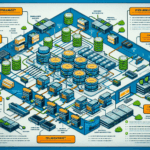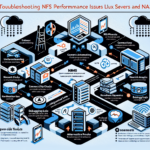Troubleshooting Slow Database Queries Caused by I/O Bottlenecks – An Enterprise Guide
When database queries slow to a crawl, one of the most overlooked causes is I/O bottlenecks. In my experience managing large enterprise systems, I’ve seen countless teams throw more CPU or memory at the problem while the real culprit was the storage layer. This guide walks through how to identify, diagnose, and resolve I/O-related query slowness using practical, production-proven techniques.
1. Understanding I/O Bottlenecks in Database Systems
I/O bottlenecks occur when the storage subsystem cannot keep up with read/write requests from the database. Common causes include:
- Underperforming disks (spinning disks instead of SSDs)
- Improper RAID configuration
- High latency from SAN/NAS
- Excessive random I/O due to poor indexing
- Contention on shared storage in virtualized environments
In enterprise setups, especially with shared SAN or hyperconverged infrastructure, storage latency spikes can cripple query performance even with high-end CPUs.
2. Step-by-Step Troubleshooting Approach
Step 1: Confirm the Symptom – Is It Really I/O?
Run initial database monitoring to see if slow queries correlate with high disk wait times.
Linux Example:
bash
iostat -x 1 10
Key metrics:
– await (average time for I/O requests) – anything consistently above 20ms on SSD storage is suspicious.
– %util – if near 100%, the disk is saturated.
Windows Example (PowerShell):
powershell
Get-Counter "\PhysicalDisk(*)\Avg. Disk sec/Read", "\PhysicalDisk(*)\Avg. Disk sec/Write"
Look for disk read/write times exceeding storage SLA.
Step 2: Identify Which Queries Are Impacted
Enable query performance profiling in your DB engine.
MySQL:
sql
SET GLOBAL slow_query_log = 'ON';
SET GLOBAL long_query_time = 1;
SHOW VARIABLES LIKE 'slow_query_log_file';
Analyze the slow query log to correlate query execution time with I/O patterns.
SQL Server:
Use Extended Events or Query Store to pinpoint slow reads and writes.
Step 3: Measure Storage Latency at Multiple Layers
In my experience, many admins only measure OS-level disk stats. You must check:
-
Database-level waits
Example for SQL Server:
sql
SELECT wait_type, wait_time_ms
FROM sys.dm_os_wait_stats
WHERE wait_type LIKE 'PAGEIOLATCH%';
IfPAGEIOLATCH_SHor_EXtimes are high, this indicates slow disk reads. -
Virtualization layer (VMware/Hyper-V) – Check datastore latency via vSphere Performance Charts.
- SAN/NAS metrics – Use vendor tools (NetApp OnCommand, Dell PowerStore Manager, etc.) to verify backend latency.
Step 4: Analyze Query Execution Plans
A common pitfall I’ve seen is blaming storage when the real issue is poor indexing causing massive table scans.
Pro-tip:
If your execution plan shows large sequential or random reads, optimize indexes before upgrading hardware.
Example in PostgreSQL:
sql
EXPLAIN (ANALYZE, BUFFERS) SELECT * FROM sales WHERE customer_id = 123;
The Buffers section will tell you if reads are coming from disk (read) instead of memory (hit).
Step 5: Optimize Storage Configuration
Once confirmed that I/O is the bottleneck:
- Switch to SSD/NVMe for critical DB volumes.
- Separate WAL/Redo logs onto dedicated low-latency storage.
- Tune RAID – RAID10 often outperforms RAID5 for databases with heavy writes.
- Increase DB cache size to reduce disk reads.
Example MySQL tuning:
ini
[mysqld]
innodb_buffer_pool_size = 8G
innodb_log_file_size = 1G
innodb_flush_method = O_DIRECT
This reduces OS-level caching conflicts and improves throughput.
Step 6: Implement Monitoring to Prevent Recurrence
In my enterprise deployments, I always set up end-to-end latency monitoring:
- OS level (
iostat,sar,perfmon) - Database wait statistics
- Storage array latency alerts
Example Prometheus Node Exporter metric for disk latency:
yaml
- job_name: 'node'
scrape_interval: 15s
static_configs:
- targets: ['dbserver01:9100']
Then create Grafana dashboards showing query execution time vs. disk latency to catch issues early.
3. Real-World Case Study
On a large SQL Server instance running on VMware, queries slowed dramatically during month-end reporting. OS metrics looked fine, but SAN latency spikes showed up in vSphere during other VM backups.
Solution: We implemented storage QoS to guarantee minimum IOPS for the DB LUNs, moved tempdb to local NVMe, and query times dropped by 70%.
4. Best Practices Summary
- Always confirm I/O as the bottleneck before making changes.
- Correlate slow query logs with disk latency metrics.
- Optimize queries and indexes first, then upgrade hardware if necessary.
- Separate high-write DB components onto low-latency storage.
- Implement proactive monitoring across OS, DB, and storage layers.
By following this structured approach, you can quickly identify and eliminate I/O bottlenecks that cripple database performance. In enterprise environments, this not only speeds up queries but also prevents costly over-provisioning of CPU and memory when the real fix is at the storage level.

Ali YAZICI is a Senior IT Infrastructure Manager with 15+ years of enterprise experience. While a recognized expert in datacenter architecture, multi-cloud environments, storage, and advanced data protection and Commvault automation , his current focus is on next-generation datacenter technologies, including NVIDIA GPU architecture, high-performance server virtualization, and implementing AI-driven tools. He shares his practical, hands-on experience and combination of his personal field notes and “Expert-Driven AI.” he use AI tools as an assistant to structure drafts, which he then heavily edit, fact-check, and infuse with my own practical experience, original screenshots , and “in-the-trenches” insights that only a human expert can provide.
If you found this content valuable, [support this ad-free work with a coffee]. Connect with him on [LinkedIn].







